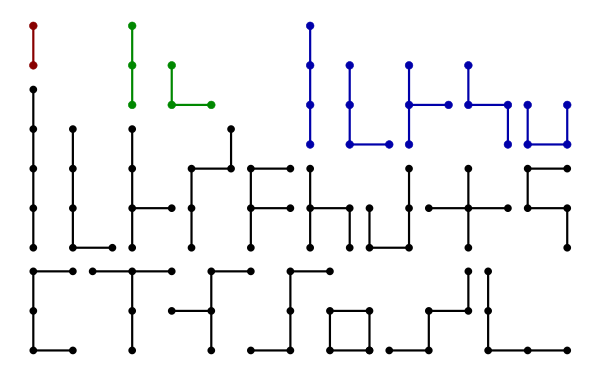Polystick
In recreational mathematics, a polystick (or polyedge) is a polyform with a line segment (a 'stick') as the basic shape. A polystick is a connected set of segments in a regular grid. A square polystick is a connected subset of a regular square grid. A triangular polystick is a connected subset of a regular triangular grid. Polysticks are classified according to how many line segments they contain.[1]
The name "polystick" seems to have been first coined by Brian R. Barwell.[2]
The names "polytrig"[3] and "polytwigs"[4] has been proposed by David Goodger to simplify the phrases "triangular-grid polysticks" and "hexagonal-grid polysticks," respectively. Colin F. Brown has used an earlier term "polycules" for the hexagonal-grid polysticks due to their appearance resembling the spicules of sea sponges.[4]
There is no standard term for line segments built on other regular tilings, an unstructured grid, or a simple connected graph, but both "polynema" and "polyedge" have been proposed.[5]
When reflections are considered distinct we have the one-sided polysticks. When rotations and reflections are not considered to be distinct shapes, we have the free polysticks. Thus, for example, there are 7 one-sided square tristicks because two of the five shapes have left and right versions.[1][6]
|
Square Polysticks | |||
| Sticks | Name | Free OEIS: A019988 | One-Sided OEIS: A151537 |
|---|---|---|---|
| 1 | monostick | 1 | 1 |
| 2 | distick | 2 | 2 |
| 3 | tristick | 5 | 7 |
| 4 | tetrastick | 16 | 25 |
| 5 | pentastick | 55 | 99 |
| 6 | hexastick | 222 | 416 |
| 7 | heptastick | 950 | 1854 |
|
Hexagonal Polysticks | |||
| Sticks | Name | Free OEIS: A197459 | One-Sided OEIS: A197460 |
|---|---|---|---|
| 1 | monotwig | 1 | 1 |
| 2 | ditwig | 1 | 1 |
| 3 | tritwigs | 3 | 4 |
| 4 | tetratwigs | 4 | 6 |
| 5 | pentatwigs | 12 | 19 |
| 6 | hexatwigs | 27 | 49 |
| 7 | heptatwigs | 78 | 143 |
|
Triangular Polysticks | |||
| Sticks | Name | Free OEIS: A159867 | One-Sided OEIS: A151539 |
|---|---|---|---|
| 1 | monostick | 1 | 1 |
| 2 | distick | 3 | 3 |
| 3 | tristick | 12 | 19 |
| 4 | tetrastick | 60 | 104 |
| 5 | pentastick | 375 | 719 |
| 6 | hexastick | 2613 | 5123 |
| 7 | heptastick | 19074 | 37936 |
The set of n-sticks that contain no closed loops is equivalent, with some duplications, to the set of (n+1)-ominos, as each vertex at the end of every line segment can be replaced with a single square of a polyomino. For example, the set of tristicks is equivalent to the set of Tetrominos. In general, an n-stick with m loops is equivalent to a (n−m+1)-omino (as each loop means that one line segment does not add a vertex to the figure).
Diagram

References
- ^ a b Weisstein, Eric W. "Polystick." From MathWorld
- ^ Brian R. Barwell, "Polysticks," Journal of Recreational Mathematics volume 22 issue 3 (1990), p.165-175
- ^ David Goodger, "An Introduction to Polytrigs (Triangular-Grid Polysticks)," (2015), http://puzzler.sourceforge.net/docs/polytrigs-intro.html
- ^ a b David Goodger, "An Introduction to Polytwigs (Hexagonal-Grid Polysticks)," (2015), http://puzzler.sourceforge.net/docs/polytwigs-intro.html
- ^ "Polynema -- from Wolfram MathWorld".
- ^ Counting polyforms, at the Solitaire Laboratory
